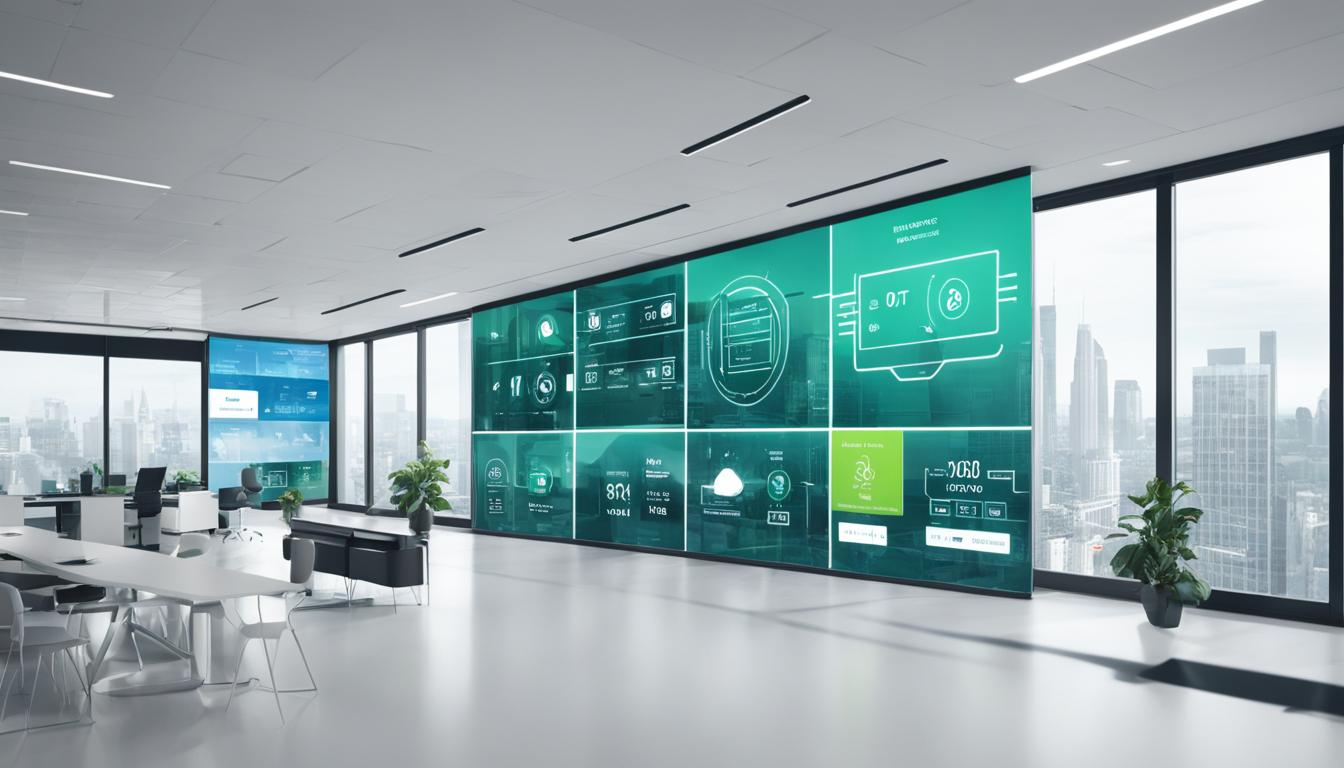The integration of Internet of Things (IoT) technology has revolutionized the way organizations approach energy efficiency. By leveraging IoT devices and platforms, businesses can optimize energy consumption, reduce costs, and contribute to a more sustainable future.
With IoT integration solutions, companies can monitor and control energy use in real-time, leading to effective energy conservation strategies. Smart thermostats and lighting systems, for example, adjust temperature and lighting based on occupancy, resulting in significant energy savings.
IoT integration also enables organizations to participate in demand response programs, reducing energy consumption during peak hours. Furthermore, by utilizing IoT-based systems, businesses can schedule energy-intensive activities for off-peak times, further optimizing energy efficiency.
Key Takeaways:
- IoT integration solutions enable organizations to monitor and control energy consumption in real-time.
- Smart thermostats and lighting systems adjust temperature and lighting based on occupancy, contributing to energy efficiency.
- Participation in demand response programs reduces energy consumption during peak hours.
- Scheduling energy-intensive activities for off-peak times optimizes energy efficiency.
- IoT integration plays a vital role in creating a more sustainable future through efficient energy management.
IoT and Building Automation for Energy Efficiency
IoT technology is revolutionizing the way buildings are managed and optimized for energy efficiency. Through the integration of IoT devices such as sensors, actuators, and smart meters, building management systems (BMS) can monitor and control energy consumption, resulting in significant energy savings.
Smart thermostats, occupancy sensors, lighting controls, HVAC controllers, and smart meters are just a few examples of IoT devices that can be utilized to achieve energy efficiency in buildings. These devices enable automated control and adjustment of temperature, lighting, and other factors based on occupancy and external conditions.
One of the key advantages of IoT devices in building automation is their ability to detect maintenance issues proactively. With sensors that enable predictive maintenance, potential problems can be identified early, preventing costly breakdowns and optimizing the overall performance of building systems.

With IoT applications in residential, commercial, and industrial spaces, as well as connected vehicles, organizations can harness the power of technology to achieve enhanced energy efficiency. By adopting IoT devices and embracing smart solutions, buildings and transportation systems can reduce energy consumption, optimize resource usage, and contribute to a more sustainable world.
Conclusion
The integration of Internet of Things (IoT) devices and building automation systems has the potential to revolutionize energy efficiency across various sectors. By harnessing the power of IoT, organizations can effectively monitor and regulate energy consumption, optimize energy usage patterns, and identify areas for improvement.
In addition to reducing energy costs and enhancing resource management, IoT technology plays a vital role in promoting sustainable energy consumption and supporting environmental policies. Through IoT applications, organizations can contribute to energy efficiency in smart cities, paving the way for a greener and more sustainable future.
The digital transformation facilitated by IoT enables greater connectivity and allows for more efficient use of natural resources. By leveraging energy-saving technologies and adopting IoT-driven strategies, businesses can pave the way for a more sustainable future, benefiting both the environment and their bottom line.
FAQ
What is IoT integration?
IoT integration refers to the process of connecting and integrating various IoT devices, platforms, and services to create a cohesive and efficient system. It involves the seamless communication and data exchange between IoT devices, enabling organizations to leverage the full potential of IoT technology.
What are the benefits of IoT integration?
IoT integration offers several benefits, including improved operational efficiency, enhanced productivity, cost savings, data-driven insights, proactive maintenance, and better decision-making. It enables organizations to streamline processes, automate tasks, and create intelligent systems that drive innovation and business growth.
What are the challenges of IoT integration?
Some challenges of IoT integration include security concerns, the complexity of integrating diverse devices and systems, data interoperability issues, scalability, privacy considerations, and the need for skilled professionals. Overcoming these challenges requires careful planning, robust security measures, standardized protocols, and a comprehensive strategy.
What are the best practices for IoT integration?
Some best practices for IoT integration include conducting a thorough assessment of organizational needs and objectives, selecting compatible and secure IoT devices and platforms, ensuring data interoperability, implementing strong security measures, testing and validating the integration solution, and continuously monitoring and updating the system.
What technologies are used for IoT integration?
Various technologies are used for IoT integration, such as APIs (Application Programming Interfaces), middleware, cloud computing, edge computing, data analytics, machine learning, artificial intelligence (AI), and blockchain. These technologies facilitate data exchange, device management, real-time analytics, and decision-making in IoT ecosystems.
What are some popular IoT integration platforms?
Some popular IoT integration platforms include Microsoft Azure IoT Hub, AWS IoT Core, Google Cloud IoT Core, IBM Watson IoT Platform, Oracle IoT Cloud, SAP Leonardo IoT, and PTC ThingWorx. These platforms provide robust tools and services for securely connecting, managing, and analyzing IoT devices and data.
Are there companies that specialize in IoT integration services?
Yes, numerous companies specialize in providing IoT integration services, including IoT system integrators and solution providers. Some well-known companies in this space include Accenture, Deloitte, IBM, Cisco, Microsoft, Intel, Amazon Web Services (AWS), and Google. These companies offer expertise in designing, implementing, and managing IoT integration solutions.
What strategies can organizations adopt for successful IoT integration?
Organizations can adopt several strategies for successful IoT integration, such as clearly defining use cases and objectives, prioritizing security and privacy, establishing strong partnerships, fostering cross-functional collaboration, conducting pilot projects, investing in training and upskilling employees, and continuously evaluating and optimizing the integration solution.
Source Links
- https://www.buildingsiot.com/blog/leverage-iot-for-energy-efficiency-in-building-management-bd
- https://www.techtarget.com/iotagenda/feature/How-to-use-IoT-for-energy-efficiency-and-sustainability
- https://www.telefonica.com/en/communication-room/blog/the-role-of-iot-in-energy-saving/
- Regulatory and Compliance: Pioneering the Future of Saudi Arabia’s Dedicated Cargo Airline - December 21, 2024
- Financial Strategies: Fueling the Growth of Saudi Arabia’s Dedicated Cargo Airline - December 20, 2024
- Operational Excellence: Ensuring Competitive Edge for Saudi Arabia’s Dedicated Cargo Airline - December 19, 2024






